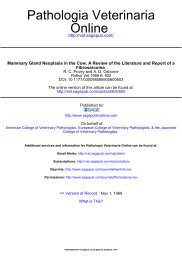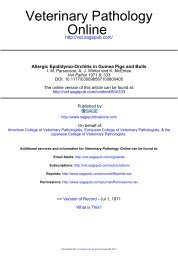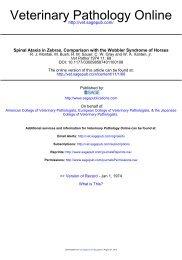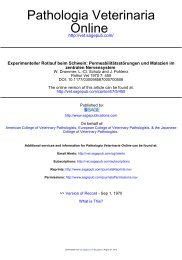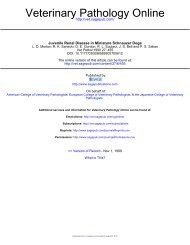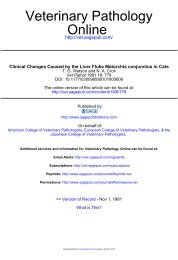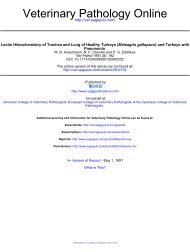The Causes of Glaucoma in Cats - Veterinary Pathology
The Causes of Glaucoma in Cats - Veterinary Pathology
The Causes of Glaucoma in Cats - Veterinary Pathology
Create successful ePaper yourself
Turn your PDF publications into a flip-book with our unique Google optimized e-Paper software.
Veter<strong>in</strong>ary <strong>Pathology</strong> Onl<strong>in</strong>e<br />
http://vet.sagepub.com/<br />
<strong>The</strong> <strong>Causes</strong> <strong>of</strong> <strong>Glaucoma</strong> <strong>in</strong> <strong>Cats</strong><br />
B. P. Wilcock, R. L. Pe<strong>of</strong>fer, Jr. and M. G. Davidson<br />
Vet Pathol 1990 27: 35<br />
DOI: 10.1177/030098589002700105<br />
<strong>The</strong> onl<strong>in</strong>e version <strong>of</strong> this article can be found at:<br />
http://vet.sagepub.com/content/27/1/35<br />
Published by:<br />
http://www.sagepublications.com<br />
On behalf <strong>of</strong>:<br />
American College <strong>of</strong> Veter<strong>in</strong>ary Pathologists, European College <strong>of</strong> Veter<strong>in</strong>ary Pathologists, & the Japanese College <strong>of</strong> Veter<strong>in</strong>ary<br />
Pathologists.<br />
Additional services and <strong>in</strong>formation for Veter<strong>in</strong>ary <strong>Pathology</strong> Onl<strong>in</strong>e can be found at:<br />
Email Alerts: http://vet.sagepub.com/cgi/alerts<br />
Subscriptions: http://vet.sagepub.com/subscriptions<br />
Repr<strong>in</strong>ts: http://www.sagepub.com/journalsRepr<strong>in</strong>ts.nav<br />
Permissions: http://www.sagepub.com/journalsPermissions.nav<br />
>> Version <strong>of</strong> Record - Jan 1, 1990<br />
What is This?<br />
Downloaded from<br />
vet.sagepub.com by guest on March 27, 2013
Vet. Pathol. 27:35-40 (1990)<br />
<strong>The</strong> <strong>Causes</strong> <strong>of</strong> <strong>Glaucoma</strong> <strong>in</strong> <strong>Cats</strong><br />
B. P. WILCOCK, R. L. PEIFFER, Jr., AND M. G. DAVIDSON<br />
Department <strong>of</strong> <strong>Pathology</strong>, University <strong>of</strong> Guelph, Guelph, Ontario, Canada;<br />
Department <strong>of</strong> Ophthalmology, University <strong>of</strong> North Carol<strong>in</strong>a, Chapel Hill, NC; and<br />
Department <strong>of</strong> Companion Animals and Special Species Medic<strong>in</strong>e,<br />
North Carol<strong>in</strong>a State University, Raleigh, NC<br />
Abstract. <strong>The</strong> cause <strong>of</strong> glaucoma <strong>in</strong> 13 1 enucleated eyes from 128 cats was determ<strong>in</strong>ed <strong>in</strong> a retrospective<br />
histologic study. Obliteration <strong>of</strong> the ciliary cleft by diffuse iridal melanoma (38 eyes), or other neoplasms (14<br />
eyes), or by the presence <strong>of</strong> idiopathic lymphocytic-plasmacytic anterior uveitis (53 eyes) were the most frequent<br />
lesions likely to expla<strong>in</strong> the development <strong>of</strong> glaucoma. Secondary changes <strong>of</strong> <strong>in</strong>ner ret<strong>in</strong>al atrophy, optic disc<br />
cupp<strong>in</strong>g, scleral th<strong>in</strong>n<strong>in</strong>g with megaglobus, and atrophy <strong>of</strong> ciliary processes were similar to those described <strong>in</strong><br />
dogs and human be<strong>in</strong>gs with chronic glaucoma. In light <strong>of</strong> the duration and seventy <strong>of</strong> the glaucoma, the degree<br />
<strong>of</strong> <strong>in</strong>ner ret<strong>in</strong>al atrophy was <strong>of</strong>ten less than expected. Diffuse corneal edema and breaks <strong>in</strong> Descemet’s membrane,<br />
changes typical <strong>of</strong> glaucoma <strong>in</strong> other species, were rarely detected. Eyes with chronic uveitis and glaucoma had<br />
collapsed ciliary clefts, iridoscleral adhesions, and posterior displacement <strong>of</strong>the <strong>in</strong>s. We were unable to determ<strong>in</strong>e<br />
whether these changes were consequences <strong>of</strong> the uveitis and thus responsible for the development <strong>of</strong> glaucoma,<br />
or if they were merely the result <strong>of</strong> the chronic glaucoma itself.<br />
Key words: Cat; glaucoma; melanoma; uveitis.<br />
In contrast to the volum<strong>in</strong>ous <strong>in</strong>formation about<br />
most aspects <strong>of</strong> glaucoma <strong>in</strong> dogs, there is scant pub-<br />
lished <strong>in</strong>formation about glaucoma <strong>in</strong> cats. Accounts<br />
<strong>in</strong> textbooks <strong>of</strong> ophthalmology, or fel<strong>in</strong>e medic<strong>in</strong>e, sug-<br />
gest that glaucoma is <strong>in</strong>frequent <strong>in</strong> cats, but that when<br />
it occurs it evokes cl<strong>in</strong>ical signs similar to those seen<br />
<strong>in</strong> dogs, has an <strong>in</strong>sidious onset, and <strong>of</strong>ten is longstand-<br />
<strong>in</strong>g prior to <strong>in</strong>itial ophthalmic e~am<strong>in</strong>ation.~J I In texts<br />
and review articles, the most common causes given for<br />
fel<strong>in</strong>e glaucoma are ocular neoplasia, lens luxation, and<br />
complications <strong>of</strong> anterior uveitis, but no published data<br />
for histologic evaluation. Most specimens were known to be<br />
be glaucomatous (as determ<strong>in</strong>ed by measurement <strong>of</strong> <strong>in</strong>tra-<br />
ocular pressure) prior to enucleation, but some eyes with<br />
suspected uveal neoplasia were identified as glaucomatous<br />
only upon histologic detection <strong>of</strong> optic disc cupp<strong>in</strong>g and gan-<br />
glion cell loss. Each globe was hardened <strong>in</strong> ethyl alcohol and<br />
was sliced to remove a central sagittal calotte for rout<strong>in</strong>e<br />
paraff<strong>in</strong> embedd<strong>in</strong>g. Sections were sta<strong>in</strong>ed with hematoxyl<strong>in</strong><br />
and eos<strong>in</strong> or with periodic acid-Schiff reagent and lux01 fast<br />
blue and were exam<strong>in</strong>ed with a light microscope. Patient<br />
data and cl<strong>in</strong>ical history were summarized from the <strong>in</strong>for-<br />
mation accompany<strong>in</strong>g each submission.<br />
are given to support these claim~.~,’-~J~ In a recent<br />
review <strong>of</strong> 29 cases <strong>of</strong> fel<strong>in</strong>e glaucoma, analysis <strong>of</strong> cl<strong>in</strong>-<br />
Results<br />
ical histories, results <strong>of</strong> ophthalmic exam<strong>in</strong>ations and<br />
ancillary laboratory tests, and results <strong>of</strong> five histo- Sixty-eight eyes had microscopic changes that readipathologic<br />
exam<strong>in</strong>ations failed to reveal a cause for ly expla<strong>in</strong>ed the development <strong>of</strong> glaucoma: obliterathe<br />
glaucoma <strong>in</strong> 27 <strong>of</strong> the 29 cats. One had iridal mel- tion <strong>of</strong> the ciliary cleft by diffuse <strong>in</strong>s melanoma (38<br />
anoma, and another had mycotic end0phtha1mitis.l~ cats) or other neoplasia (14 cats), corneal perforation<br />
In the only other published report we were able to f<strong>in</strong>d, with extensive anterior synechiae (8 cats), posterior<br />
bilateral glaucoma <strong>in</strong> a 3-year-old Siamese cat was synechiae and pupillary block follow<strong>in</strong>g traumatic lens<br />
associated with chronic anterior uveitis and peripheral rupture (4 cats), fibrovascular pre-iridal membrane with<br />
anterior ~ynechia.~<br />
angle overgrowth (3 cats), and anterior entrapment <strong>of</strong><br />
In this study, we exam<strong>in</strong>ed 13 1 glaucomatous, enu- the iris by an <strong>in</strong>tumescent lens (1 cat) (Figs. 1, 2). <strong>The</strong><br />
cleated eyes from 128 cats <strong>in</strong> an attempt to determ<strong>in</strong>e glaucoma <strong>in</strong> the rema<strong>in</strong><strong>in</strong>g 63 eyes was less easily exthe<br />
causes <strong>of</strong> glaucoma <strong>in</strong> cats and to characterize the pla<strong>in</strong>ed. Four had anterior luxation <strong>of</strong> the lens but no<br />
ocular changes caused by the glaucoma.<br />
detectable change <strong>in</strong> the filtration angle other than collapse<br />
<strong>of</strong> the ciliary cleft attributed to the glaucoma<br />
Materials and Methods<br />
itself. Three cats had bilateral glaucoma with no ob-<br />
Enucleated eyes, fixed <strong>in</strong> 10% neutral buffered formal<strong>in</strong>, served primary lesion and were classified as open-anor<br />
<strong>in</strong> Zenker’s or Bou<strong>in</strong>’s fluid, were submitted by general gle, open-cleft primary glaucoma. <strong>The</strong> largest group<br />
veter<strong>in</strong>ary practitioners or by veter<strong>in</strong>ary ophthalmologists (5 3 cats) had lymphocytic-plasmacytic anterior uveitis.<br />
35<br />
Downloaded from<br />
vet.sagepub.com by guest on March 27, 2013
36 Wilcock, Peiffer, and Davidson<br />
Fig. 1. Cat with diffuse iridal melanoma and secondary glaucoma. Note obliteration <strong>of</strong> the ciliary cleft. HE.<br />
Fig. 2. Cat with <strong>in</strong>tumescent, cataractous lens. Note the anterior displacement <strong>of</strong> the iris, narrow<strong>in</strong>g <strong>of</strong> the filtration<br />
angle, and secondary glaucoma. HE<br />
Fig. 3. Lymphoid aggregates <strong>in</strong> iridal stroma, typical <strong>of</strong> most cases <strong>of</strong> uveitis <strong>in</strong> this study. HE.<br />
Fig. 4. Normal configuration <strong>of</strong> the filtration angle <strong>in</strong> a healthy, normotensive cat eye. <strong>The</strong> trabecular meshwork is lacey<br />
and the iridocorneal angle is acute. <strong>The</strong> term<strong>in</strong>ation <strong>of</strong> Descemet’s membrane (arrow) marks the most anterior <strong>in</strong>sertion<br />
<strong>of</strong> the pect<strong>in</strong>ate (trabecular) fibers. HE.<br />
Downloaded from<br />
vet.sagepub.com by guest on March 27, 2013
Chronic uveitis<br />
Primary Ocular Change<br />
Cat <strong>Glaucoma</strong> 37<br />
Table 1. <strong>The</strong> causes <strong>of</strong> glaucoma <strong>in</strong> cats.<br />
Number <strong>of</strong><br />
Eyes*<br />
53<br />
Iridal melanoma<br />
38<br />
Uveal lymphoma<br />
8<br />
Corneal ulceration and/or perforation 8<br />
Lens rupture<br />
4<br />
Primary ocular sarcoma<br />
4<br />
Anterior lens luxation<br />
4<br />
Rubeosis iridis<br />
3<br />
Primary open angle<br />
3<br />
Metastatic carc<strong>in</strong>oma<br />
2<br />
Intumescent cataract<br />
1<br />
* 128 eyes from 13 1 cats: three had bilateral open angle glaucoma.<br />
No etiologic agent was seen, and no cat was systemi-<br />
cally ill (Table 1).<br />
Histologically, the uveitis had two major patterns<br />
that were not necessarily mutually exclusive. <strong>The</strong> most<br />
frequent pattern was a diffuse lymphocytic-plasma-<br />
cytic anterior uveitis. <strong>The</strong> leukocytes were most prom-<br />
<strong>in</strong>ent <strong>in</strong> perivascular locations with<strong>in</strong> iridal stroma and<br />
anterior ciliary body, but occasionally could be found<br />
perivascularly with<strong>in</strong> choroid and ret<strong>in</strong>a. A second pat-<br />
tern, usually superimposed on the first, was the pres-<br />
ence <strong>of</strong> discrete lymphoid aggregates with<strong>in</strong> the iris,<br />
trabecular meshwork, and ciliary body (Fig. 3).<br />
<strong>The</strong> cl<strong>in</strong>ical histories for 2 1 <strong>of</strong> the 5 3 eyes with uve-<br />
itis revealed that the uveitis preceded the onset <strong>of</strong> glau-<br />
coma. None <strong>of</strong> the histories stated that the glaucoma<br />
preceded the uveitis, and most <strong>of</strong> them simply record-<br />
ed a long history <strong>of</strong> glaucoma and uveitis with no pro<strong>of</strong><br />
<strong>of</strong> which had occurred first. <strong>The</strong> histologic lesions sup-<br />
port speculation for three mechanisms by which the<br />
uveitis may have caused glaucoma, and <strong>in</strong> cats with<br />
complex lesions, there may have been more than one<br />
contributor to the glaucoma. In ten eyes, the accu-<br />
mulation <strong>of</strong> leukocytes on the face <strong>of</strong> the pect<strong>in</strong>ate<br />
ligament or with<strong>in</strong> the trabecular meshwork was suf-<br />
ficient to justify speculation that outflow had been im-<br />
paired (Figs. 4, 5). In eight eyes, the obstruction was<br />
attributed to numerous lymphoid aggregates with<strong>in</strong> the<br />
trabecular meshwork and adjacent uveal stroma. In 28<br />
eyes, there was collapse <strong>of</strong> the ciliary cleft, adherence<br />
<strong>of</strong> the peripheral iris to the sclera or (rarely) peripheral<br />
cornea, and formation <strong>of</strong> a false angle with<strong>in</strong> the mid-<br />
periphery <strong>of</strong> the iris (Figs. 6, 7). In seven eyes with<br />
uveitis, there was no lesion that we were able to identify<br />
as a probable cause for the glaucoma.<br />
Many <strong>of</strong> the structural alterations attributed to the<br />
chronic glaucoma were similar to those seen <strong>in</strong> other<br />
species: atrophy <strong>of</strong> ciliary processes and <strong>in</strong>ner ret<strong>in</strong>al<br />
layers, cupp<strong>in</strong>g <strong>of</strong> the optic disc, scleral th<strong>in</strong>n<strong>in</strong>g, mega-<br />
Mechanism <strong>of</strong> <strong>Glaucoma</strong><br />
Occlusion <strong>of</strong> trabecular meshwork by cellular exudate, lymphoid<br />
nodules, or peripheral anterior synechia<br />
Tumor obliteration <strong>of</strong> trabecular meshwork<br />
Occlusion <strong>of</strong> trabecular meshwork<br />
Extensive anterior synechiae<br />
Pupillary occlusion by perilenticular <strong>in</strong>flammation and fibroplasia<br />
Pupillary and angle obstruction<br />
Unknown<br />
Angle traversed by fibrovascular preiridal membrane<br />
Unknown-angle and cleft histologically normal<br />
Uveal fibr<strong>in</strong>ous <strong>in</strong>flammation posterior synechiae<br />
Anterior iris entramnent<br />
Downloaded from<br />
vet.sagepub.com by guest on March 27, 2013<br />
globus, and corneal stromal va~cularization.~~~J~ <strong>The</strong><br />
corneal vascularization was usually subtle, except <strong>in</strong><br />
14 eyes that had corneal ulceration. In seven, the ulceration<br />
was the primary lesion, usually <strong>in</strong> young cats<br />
and usually associated with a history <strong>of</strong> ocular trauma.<br />
Corneal perforation, iris prolapse, and complete anterior<br />
synechia resulted <strong>in</strong> glaucoma. In the rema<strong>in</strong><strong>in</strong>g<br />
seven eyes, the ulceration was a complication <strong>of</strong> the<br />
glaucoma (presumably because <strong>of</strong> megaglobus, corneal<br />
protrusion, and <strong>in</strong>creased susceptibility to trauma or<br />
desiccation), and <strong>in</strong> five <strong>of</strong> the seven it was responsible<br />
for the decision to enucleate.<br />
<strong>The</strong> atrophy <strong>of</strong> the nerve fiber layer and loss <strong>of</strong> ganglion<br />
cells characteristic <strong>of</strong> glaucoma were seen <strong>in</strong> 1 10<br />
<strong>of</strong> the 1 13 eyes. In three cats with unequivocal cl<strong>in</strong>ical<br />
diagnoses <strong>of</strong> glaucoma, we could not confirm ret<strong>in</strong>al<br />
atrophy. <strong>The</strong> atrophy was <strong>of</strong>ten subtle despite the fact<br />
that most <strong>of</strong> these eyes had glaucoma for several months<br />
or even years (Fig. 8). Usually, the ret<strong>in</strong>a overly<strong>in</strong>g the<br />
tapetum was less severely affected than the ret<strong>in</strong>a from<br />
the ventral, non-tapetal fundus. Diffise corneal edema,<br />
a hallmark <strong>of</strong> uncontrolled glaucoma <strong>in</strong> dogs and human<br />
be<strong>in</strong>gs, was not seen <strong>in</strong> any <strong>of</strong> our fel<strong>in</strong>e specimens<br />
except <strong>in</strong> those <strong>in</strong> which it was attributed to concurrent<br />
corneal ulcerati~n.~>~J~ Similarly, the multifocal breaks<br />
<strong>in</strong> Descemet’s membrane caused by pressure-<strong>in</strong>duced<br />
corneal stretch<strong>in</strong>g (striate keratopathy) were seen only<br />
<strong>in</strong> two cats despite what, <strong>in</strong> many eyes, was a marked<br />
megaglobus.<br />
Discussion<br />
Review articles based upon cl<strong>in</strong>ical experience with<br />
fel<strong>in</strong>e glaucoma list the follow<strong>in</strong>g as the most frequent<br />
causes <strong>of</strong> glaucoma <strong>in</strong> cats: angle obstruction by <strong>in</strong>flammatory<br />
debris or by post-<strong>in</strong>flammatory synechiae,<br />
angle occlusion by primary or by metastatic uveal neoplasia,<br />
and lens luxation.8B’2 <strong>The</strong> last is controversial<br />
because <strong>of</strong> the difficulty <strong>of</strong> establish<strong>in</strong>g whether the
38 Wilcock, Peiffer, and Davidson<br />
Fig. 5. Leukocytes are on the anterior face <strong>of</strong> the iris and with<strong>in</strong> the ciliary cleft, a possible cause <strong>of</strong> obstruction to<br />
aqueous outflow.<br />
Fig. 6. Ciliary cleft, filled with leukocytes; iridal root is displaced posteriorly, creat<strong>in</strong>g a false angle (arrow). HE.<br />
Fig. 7. Collapse <strong>of</strong> the ciliary cleft and formation <strong>of</strong> a false angle with<strong>in</strong> the peripheral iris. <strong>The</strong> altered angle between<br />
the iris and sclera deepens the anterior chamber. Note that the new “angle” is very posterior to the term<strong>in</strong>ation <strong>of</strong> Descemet’s<br />
membrane (arrow). HE.<br />
Fig, 8. Loss <strong>of</strong> ganglion cells and nerve fiber layer <strong>in</strong> glaucomatous ret<strong>in</strong>a 1 mm dorsal to the optic disc. Nerve fiber<br />
loss has resulted <strong>in</strong> unusual prom<strong>in</strong>ence <strong>of</strong> the Mueller fibers (arrow). HE.<br />
Downloaded from<br />
vet.sagepub.com by guest on March 27, 2013
Cat <strong>Glaucoma</strong> 39<br />
lens dislocation occurred as a result <strong>of</strong> the glaucoma <strong>of</strong> a wide variety <strong>of</strong> antigens, <strong>in</strong>clud<strong>in</strong>g those native to<br />
(zonular stretch<strong>in</strong>g) or was the cause <strong>of</strong> the glaucoma the eye itself.1° Unmask<strong>in</strong>g these sequestered (or parby<br />
forward entrapment <strong>of</strong> the iris (angle closure) or by tially sequestered) antigens <strong>of</strong> lenticular, uveal, or retallow<strong>in</strong>g<br />
vitreous prolapse (pupillary blo~k).~,~ Some <strong>in</strong>al orig<strong>in</strong> is thought to be critical to the development<br />
<strong>of</strong> these cl<strong>in</strong>ical impressions are substantiated by this <strong>of</strong> nonsuppurative uveitis follow<strong>in</strong>g a wide range <strong>of</strong><br />
retrospective histologic study.<br />
traumatic, <strong>in</strong>flammatory, or degenerative ocular dis-<br />
Diffuse iridal melanoma is a lead<strong>in</strong>g cause <strong>of</strong> glau- order~.~J~ In human be<strong>in</strong>gs and domestic animals, the<br />
coma <strong>in</strong> cats, account<strong>in</strong>g for one-third <strong>of</strong> our cases. syndrome is only partially controlled by anti-<strong>in</strong>flam-<br />
<strong>The</strong> tendency for these tumors to <strong>in</strong>filtrate the ciliary matory and immunosuppressive therapy, with evencleft<br />
and to cause glaucoma has previously been re- tual enucleation justified by <strong>in</strong>tractable ocular pa<strong>in</strong>,<br />
p~rted.l,~.‘j In 15 <strong>of</strong> the 37 eyes <strong>in</strong> our study, it was the glaucoma, or bl<strong>in</strong>dness.<br />
glaucoma rather than the cl<strong>in</strong>ically undetected neo- Although we believe that the uveitis caused the evenplasm<br />
that prompted enucleation.<br />
tual glaucoma, how it did so is not clear, partly because<br />
Our results support the cl<strong>in</strong>ical observation that many most <strong>of</strong> the eyes had longstand<strong>in</strong>g disease with seccats<br />
with glaucoma have concurrent anterior uveitis, ondary compression <strong>of</strong> the filtration angle that made<br />
yet we cannot confirm that there is a causal relationship evaluation very difficult. In the 25 eyes with uveitis<br />
between the two. In most <strong>in</strong>stances, the first detailed that still had open angles, ten had enough entrapped<br />
ophthalmic cl<strong>in</strong>ical exam<strong>in</strong>ation was <strong>of</strong> an eye with leukocytes to justify speculation that the leukocytes<br />
longstand<strong>in</strong>g disease, so that most <strong>of</strong> the histories ac- themselves may be obstruct<strong>in</strong>g the passage <strong>of</strong> aqueous<br />
company<strong>in</strong>g our specimens had noncommittal state- humor through the trabecular meshwork. Eight more<br />
ments such as “chronic glaucoma” or “chronic uveitis had lympohid aggregates with<strong>in</strong> the trabecular meshand<br />
glaucoma.” Nonetheless, 2 1 histories specifically work as well as <strong>in</strong> the more usual location with<strong>in</strong> the<br />
stated that the uveitis preceded the glaucoma, and none iridal stroma, and we believe that such lymphoid prospecifically<br />
stated that the uveitis followed the ob- liferation could also be obstructive. <strong>The</strong> rema<strong>in</strong><strong>in</strong>g sevserved<br />
onset <strong>of</strong> the glaucoma. Our <strong>in</strong>cl<strong>in</strong>ation to accept en eyes with lymphocytic-plasmacytic uveitis and open<br />
that the uveitis somehow causes the glaucoma is fur- ciliary clefts had no histologic lesion to expla<strong>in</strong> the<br />
ther supported by histopathology. Six eyes with pri- development <strong>of</strong> glaucoma, although we must admit<br />
mary glaucoma, four eyes with anterior lens luxation, that the number <strong>of</strong> leukocytes with<strong>in</strong> the trabecular<br />
and most <strong>of</strong> the eyes with uveal melanoma had no meshwork sufficient to cause obstruction is unknown.<br />
<strong>in</strong>flammation. This suggests that <strong>in</strong> cats, as <strong>in</strong> dogs and Our decision as to what number qualifies an eye for<br />
human be<strong>in</strong>gs, glaucoma per se does not cause uveitis placement <strong>in</strong> our “cleft occlusion’’ category is admitand<br />
that the uveitis must be considered either as the tedly arbitrary. Our experience with glaucoma <strong>in</strong> dogs<br />
primary lesion or a concurrent, <strong>in</strong>dependent e~ent.~,’~ had not prepared us to seriously consider cleft occlu-<br />
Because it was not seen as a concurrent lesion <strong>in</strong> the sion by leukocytes as a major category <strong>in</strong> carnivores<br />
other categories <strong>of</strong> glaucoma <strong>in</strong> this study, we conclude s<strong>in</strong>ce, <strong>in</strong> dogs, the way <strong>in</strong> which uveitis causes glauthat<br />
lymphocytic-plasmacytic uveitis is the cause <strong>of</strong> a coma is almost always via posterior synechia with or<br />
substantial proportion <strong>of</strong> the cases <strong>of</strong> glaucoma <strong>in</strong> cats. without <strong>in</strong>s b~mbC.~,~ In our series, only one kitten<br />
<strong>The</strong> pathogenesis <strong>of</strong> the uveitis <strong>in</strong> virtually all <strong>of</strong> with corneal perforation and fibr<strong>in</strong>opurulent endophthese<br />
cases is unknown. Most histories did not specify thalmitis had posterior synechia as the cause for glauthe<br />
extent <strong>of</strong> test<strong>in</strong>g for such agents as fel<strong>in</strong>e leukemia coma.<br />
virus, toxoplasma, or the coronavirus <strong>of</strong> fel<strong>in</strong>e <strong>in</strong>fec- Idiopathic, lymphocytic-plasmacytic uveitis, virtious<br />
peritonitis, which are all frequent causes <strong>of</strong> uveitis tually identical to that seen <strong>in</strong> our series <strong>of</strong> cats, is the<br />
<strong>in</strong> cat~.~,~Jl Because none <strong>of</strong> these cats was systemically most frequent type <strong>of</strong> uveitis <strong>in</strong> human be<strong>in</strong>gs.’J5 When<br />
ill, and because the uveitis was reported to be unilateral it leads to glaucoma, it does so via posterior or anterior<br />
<strong>in</strong> 50 <strong>of</strong> the 53 affected cats, we conclude that these synechiae, overgrowth <strong>of</strong> the filtration angle by preagents<br />
are unlikely to have been the cause <strong>of</strong> the uveitis. iridal vascular membrane or corneal endothelium, or<br />
As <strong>in</strong> cats, the pathogenesis <strong>of</strong> most examples <strong>of</strong> lym- by fill<strong>in</strong>g the trabecular meshwork with mononuclear<br />
phocytic-plasmacytic uveitis <strong>in</strong> human be<strong>in</strong>gs and oth- leukocytes. After review<strong>in</strong>g some <strong>of</strong> the photographs<br />
er animals is unknown. Failure to identify an etiologic <strong>of</strong> that last group (trabecular fill<strong>in</strong>g), it seems to us that<br />
agent, dom<strong>in</strong>ance <strong>of</strong> lymphocytes and plasma cells, the evidence for outflow obstruction caused directly<br />
and at least partial suppression by corticosteroids or by the leukocytes is weak and mostly arises (as <strong>in</strong> our<br />
other immunosuppressive agents support speculation cats) from the <strong>in</strong>ability to histologically identify any<br />
that most cases are the result <strong>of</strong> immune-mediated other cause.<br />
disease. This belief is supported by the experimental Twenty-eight <strong>of</strong> the 53 glaucomatous eyes with lym<strong>in</strong>duction<br />
<strong>of</strong> similar lesions by <strong>in</strong>traocular <strong>in</strong>stillation phocytic-plasmacytic uveitis had adhesion <strong>of</strong> the iridal<br />
Downloaded from<br />
vet.sagepub.com by guest on March 27, 2013
40 Wilcock, Peiffer, and Davidson<br />
root to adjacent sclera, thereby obliterat<strong>in</strong>g the ciliary<br />
cleft and, frequently, creat<strong>in</strong>g a false angle with<strong>in</strong> the<br />
peripheral iris. Unlike a typical anterior synechia, the<br />
adhesion was not to the peripheral cornea but to the<br />
sclera posterior to the term<strong>in</strong>ation <strong>of</strong> Descemet’s mem-<br />
brane, and there was no other evidence <strong>of</strong> a resolved<br />
fibr<strong>in</strong>ous exudate (such as posterior synechia or ectro-<br />
pion uveae) that presumably would have preceded the<br />
mature adhesion. <strong>Cats</strong> seem quite resistant to any type<br />
<strong>of</strong> iridal adhesion as evidenced by their rarity even <strong>in</strong><br />
such exudative uveal diseases as cryptococcosis and<br />
fel<strong>in</strong>e <strong>in</strong>fectious peritonitis.12 It is possible that the<br />
iridoscleral adhesion is really just angle compression,<br />
which may occur as a result <strong>of</strong> chronically elevated<br />
<strong>in</strong>traocular pressure.15 Based upon our histologic stud-<br />
ies, we are conv<strong>in</strong>ced that the iridoscleral adhesion <strong>in</strong><br />
most <strong>of</strong> these cats is the result <strong>of</strong> a local sclerotic pro-<br />
cess that is limited to the trabecular meshwork, rather<br />
than a result <strong>of</strong> a generalized exudative process. <strong>The</strong><br />
sclerosis draws the root <strong>of</strong> the iris aga<strong>in</strong>st the sclera<br />
and thereby elim<strong>in</strong>ates the ciliary cleft. <strong>The</strong> free por-<br />
tion <strong>of</strong> the iris is thereby shortened and the iridocorneal<br />
angle rendered more obtuse, giv<strong>in</strong>g the cl<strong>in</strong>ical impres-<br />
sion <strong>of</strong> a dilated pupil and a deepened anterior chamber<br />
that were typical cl<strong>in</strong>ical observations <strong>in</strong> this series <strong>of</strong><br />
cats.<br />
Our observation <strong>of</strong> histologically normal iridocor-<br />
neal angles and ciliary clefts <strong>in</strong> three young cats with<br />
bilateral glaucoma is, to our knowledge, the first his-<br />
tologic evidence to support the cl<strong>in</strong>ical evidence for<br />
the existence <strong>of</strong> primary open-angle glaucoma <strong>in</strong><br />
cats. ‘,I3<br />
References<br />
1 Acland GM, McLean IW, Aguirre GD, Trucksa R: Dif-<br />
fuse iris melanoma <strong>in</strong> cats. J Am Vet Med Assoc 176:<br />
52-56, 1980<br />
2 Bedford PGD <strong>The</strong> cl<strong>in</strong>ical and pathological features <strong>of</strong><br />
can<strong>in</strong>e glaucoma. Vet Rec 108:53-58, 1980<br />
3 Brightman AH: <strong>The</strong> eye. In: Fel<strong>in</strong>e Medic<strong>in</strong>e, ed. Pratt<br />
P, pp. 605-622. American Veter<strong>in</strong>ary Publications, Santa<br />
Barbara, CA, 1983<br />
4 Coop MC, Thomas JR: Bilateral glaucoma <strong>in</strong> the cat. J<br />
Am Vet Med Assoc 133:369-370, 1958<br />
5 Dubielzig RR, Everett J, Shadduck JA, Albert DM: Fel<strong>in</strong>e<br />
ocular and posttraumatic sarcoma. 37th Annu Meet<br />
Am Coll Vet Pathol, p. 119. New Orleans, LA, 1986<br />
6 Duncan DE, Peiffer RL: Morphologic and behavioral<br />
characteristics <strong>of</strong> fel<strong>in</strong>e uveal melanomas. 38th Annu<br />
Meet Am Coll Vet Pathol, p. 71. Monterey, CA, 1987<br />
7 Green WR: Inflammatory diseases and conditions <strong>of</strong> the<br />
eye. In: Ophthalmic <strong>Pathology</strong>, ed. Spencer W, 3rd ed.,<br />
pp. 2003-2008. WB Saunders, Philadelphia, PA, 1986<br />
8 Mart<strong>in</strong> CL: Fel<strong>in</strong>e ophthalmologic diseases: the anterior<br />
chamber and glaucoma. Mod Vet Pract 63:209-2 13,1982<br />
9 Mart<strong>in</strong> CL: <strong>The</strong> pathology <strong>of</strong> glaucoma. In: Comparative<br />
Ophthalmic <strong>Pathology</strong>, ed. Peiffer RL, pp. 137-169.<br />
Charles Thomas, Spr<strong>in</strong>gfield, IL, 1983<br />
10 O’Connor GR: Basic mechanisms responsible for the<br />
<strong>in</strong>itiation and recurrence <strong>of</strong> uveitis. Am J Ophthalmol<br />
96~577-599, 1983<br />
11 Peiffer RL Fel<strong>in</strong>e ophthalmology. In: Veter<strong>in</strong>ary Oph-<br />
thalmology, ed. Gellat KN, pp. 547-549. Lea and Fe-<br />
biger, Philadelphia, PA, 198 1<br />
12 Peiffer RL, Wilcock BP: A survey <strong>of</strong> fel<strong>in</strong>e uveitis. Trans<br />
19th Annu Sci Meet Am Coll Vet Ophthalmol, pp. 41-<br />
42. Las Vegas, NV, 1988<br />
13 Ridgway MD, Brightman AH: Fel<strong>in</strong>e glaucoma: a ret-<br />
rospective study <strong>of</strong> 29 cl<strong>in</strong>ical cases. Trans 17th Annu<br />
Sci Meet Am Coll Vet Ophthalmol, pp. 141-150. New<br />
Orleans, LA 1986<br />
14 Whitley RD, Moore CP: Advances <strong>in</strong> fel<strong>in</strong>e ophthal-<br />
mology. Vet Cl<strong>in</strong> North Am [Small h im Pract] 14: 127 1-<br />
1288, 1984<br />
15 Yan<strong>of</strong>f M, F<strong>in</strong>e BS: Ocular <strong>Pathology</strong>: A Text and Atlas,<br />
2nd ed., p. 775. Harper and Row, Philadelphia, PA, 1982<br />
Request repr<strong>in</strong>ts from Dr. Brian Wilcock, Department <strong>of</strong> <strong>Pathology</strong>, Ontario Veter<strong>in</strong>ary College, Guelph, Ontario, Canada<br />
N1G 2W1 (Canada).<br />
Downloaded from<br />
vet.sagepub.com by guest on March 27, 2013




